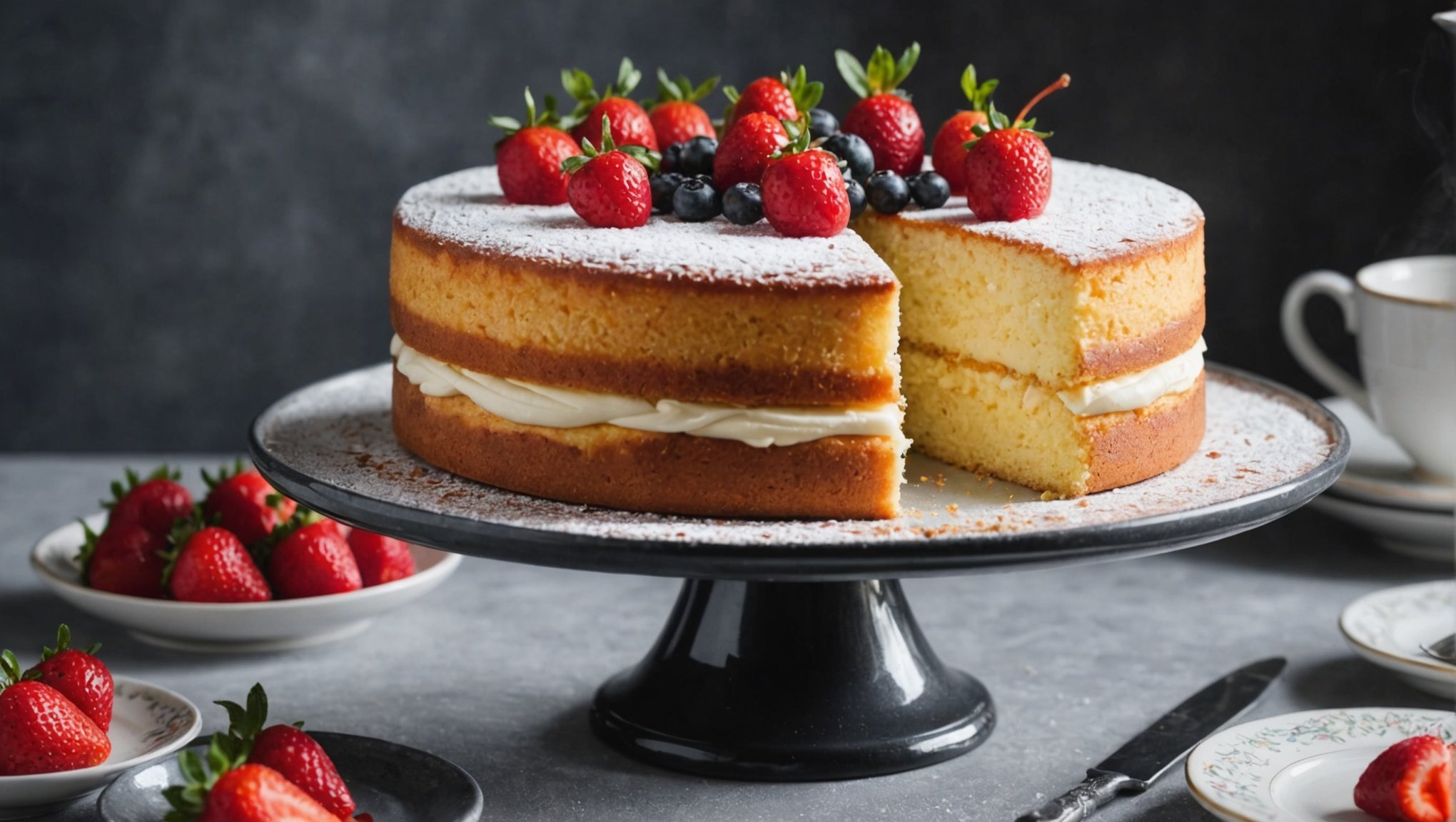Unlock the Secrets to Crafting a Perfectly Fluffy Victoria Sponge Cake: Tips and Techniques Revealed!
Understanding the Basics of a Victoria Sponge Cake
When it comes to classic British desserts, the Victoria sponge cake stands out as a timeless favorite, known for its light, fluffy texture and delicate flavor. This cake, named after Queen Victoria, is a staple at tea parties and gatherings, and its simplicity belies the precision and technique required to make it perfectly.
To start, it’s essential to understand the core components of a Victoria sponge cake. The cake consists of two layers of sponge cake, typically made with eggs, sugar, flour, and butter, filled with a layer of jam and often topped with a dusting of icing sugar. Here’s a breakdown of the key ingredients:
Also to see : Mastering the Art of Grilling Halloumi: Essential Tips for a Zesty Lemon and Mint Delight!
- Eggs: Large eggs are crucial for the structure and moisture of the cake. Separating the egg whites from the yolks is a critical step, as we will discuss later.
- Sugar: Caster sugar is preferred for its fine texture, which helps in creating a smooth batter.
- Flour: Cake flour or self-raising flour is ideal due to its lower protein content, which helps in achieving a tender crumb.
- Butter: Unsalted butter, softened to room temperature, is essential for the cake’s flavor and texture.
- Vanilla Extract: A hint of vanilla extract can enhance the flavor of the cake.
Preparing Your Baking Equipment and Ingredients
Before you begin mixing your ingredients, it’s vital to prepare your baking equipment and ensure all ingredients are at the right temperature.
Preheating the Oven and Preparing the Cake Pans
Preheat your oven to 350°F (175°C). Use two 8-inch round cake pans and line the bottoms with parchment paper to ensure the cakes come out easily. Greasing the sides of the pans lightly can also help.
Have you seen this : Unlocking the Secrets to a Luxuriously Creamy English Blancmange: The Ultimate Recipe Guide!
Ensuring Room Temperature Ingredients
Make sure all your ingredients, especially the eggs and butter, are at room temperature. This helps in creating a smooth and even batter. Cold ingredients can lead to a dense cake, so it’s worth taking the time to let them warm up.
The Mixing Process: Separating Eggs and Whipping
The mixing process is where the magic happens, and it requires some finesse.
Separating Egg Whites and Yolks
Separating the egg whites from the yolks is a delicate process. Here are some tips to make it easier:
- Use Clean and Dry Tools: Any fat or moisture can prevent the egg whites from whipping properly.
- Crack Each Egg into a Small Bowl: This way, if a yolk breaks, you won’t spoil the entire batch of egg whites.
- Whip the Egg Whites: Whip the egg whites until they form stiff peaks. This can take about 15 minutes with an electric mixer. Look for the point where the mixture stays firm on the whisk.
Whipping the Egg Yolks and Sugar
Beat the egg yolks and sugar together until light and fluffy. This step is crucial for incorporating air into the batter.
Combining the Egg Whites and Yolks
Gently fold the whipped egg whites into the egg yolk and sugar mixture. This step requires patience to avoid deflating the batter. Here’s a detailed approach:
- Add a Small Amount of Egg Whites: Start by adding a small amount of the whipped egg whites to the egg yolk mixture to lighten it.
- Fold Gently: Use a spatula to gently fold the remaining egg whites into the mixture, ensuring you maintain as much air as possible.
Adding Flour and Other Ingredients
The next step is to incorporate the flour and other dry ingredients into the batter.
Sifting the Flour Mixture
Sift the flour mixture (including any baking powder or salt) over the egg mixture to ensure even distribution. This helps in maintaining the air bubbles in the batter.
Adding Butter and Vanilla Extract
Gently fold in the softened butter and a hint of vanilla extract into the batter. This adds flavor and helps in creating a smooth texture.
Baking the Cakes
Baking is a critical step where the texture and structure of the cake are finalized.
Pouring the Batter into Pans
Divide the batter evenly between the two prepared cake pans. Smooth the tops to ensure even baking.
Baking Time and Temperature
Bake the cakes at 350°F (175°C) for about 20-25 minutes or until they are golden brown and spring back when touched. A quick spring back indicates that the cakes are done.
Cooling and Assembling the Cake
Cooling and assembling the cake are the final steps to achieving that perfect Victoria sponge.
Cooling the Cakes
Let the cakes cool completely in the pans before transferring them to a wire rack to cool further. This helps in preventing the cakes from breaking apart.
Assembling the Cake
Once the cakes are completely cool, place one layer on a serving plate and spread a layer of jam on top. You can use any type of jam, but raspberry or strawberry are traditional choices. Place the second layer on top and dust with icing sugar.
Key Tips for Baking a Fluffy Sponge Cake
Here are some key tips to ensure your Victoria sponge cake turns out perfectly fluffy:
- Master Egg Separation: Keep the yolk away from the whites for a good meringue. Use clean, dry tools to prevent mixing.
- Maintain Room Temperature: Ensure all ingredients are at room temperature to create a smooth and even batter.
- Don’t Overmix: Fold the ingredients gently to avoid deflating the batter.
- Use the Right Flour: Cake flour or self-raising flour is ideal for a tender crumb.
- Bake at the Right Temperature: Bake at 350°F (175°C) to ensure even baking.
Common Mistakes to Avoid
Here are some common mistakes to avoid when making a Victoria sponge cake:
- Overmixing the Batter: This can lead to a dense cake.
- Using Cold Ingredients: Cold ingredients can prevent the batter from mixing smoothly.
- Not Sifting the Flour: Failing to sift the flour can result in an uneven distribution of ingredients.
- Overbaking: Overbaking can make the cake dry and dense.
Detailed Recipe for a Perfect Victoria Sponge Cake
Here is a detailed recipe to help you make a perfectly fluffy Victoria sponge cake:
Ingredients
| Ingredient | Quantity |
|---|---|
| Large Eggs | 4 |
| Caster Sugar | 1 cup |
| Cake Flour | 1 cup |
| Unsalted Butter | 1/2 cup |
| Vanilla Extract | 1 tsp |
| Baking Powder | 1 tsp |
| Salt | A pinch |
| Jam | For filling |
| Icing Sugar | For dusting |
Instructions
- Preheat the Oven: Preheat the oven to 350°F (175°C).
- Prepare the Cake Pans: Line the bottoms of two 8-inch round cake pans with parchment paper.
- Separate the Eggs: Separate the egg whites from the yolks.
- Whip the Egg Whites: Whip the egg whites until they form stiff peaks.
- Beat the Egg Yolks and Sugar: Beat the egg yolks and sugar together until light and fluffy.
- Combine the Egg Whites and Yolks: Fold the whipped egg whites into the egg yolk mixture gently.
- Add Flour and Other Ingredients: Sift the flour mixture over the egg mixture and fold in gently. Add the softened butter and vanilla extract.
- Bake the Cakes: Divide the batter evenly between the two prepared cake pans and bake for 20-25 minutes.
- Cool the Cakes: Let the cakes cool completely in the pans before transferring them to a wire rack.
- Assemble the Cake: Place one layer on a serving plate, spread a layer of jam on top, and place the second layer on top. Dust with icing sugar.
Practical Insights and Actionable Advice
Here are some practical insights and actionable advice to help you perfect your Victoria sponge cake:
- Use High-Quality Ingredients: High-quality ingredients, such as fresh eggs and real vanilla extract, can make a significant difference in the flavor and texture of your cake.
- Don’t Rush the Process: Take your time when mixing and folding the ingredients to ensure you maintain the air bubbles in the batter.
- Practice Makes Perfect: Making a Victoria sponge cake is an art that requires practice. Don’t be discouraged if your first attempt doesn’t turn out perfectly.
Quotes from Expert Bakers
Here are some quotes from expert bakers that highlight the importance of technique and quality ingredients:
- “The key to a perfect Victoria sponge is in the separation and whipping of the eggs. It’s all about maintaining those air bubbles to get that light and fluffy texture,” – Monique, The Station Bakery.
- “Using room temperature ingredients is crucial. It ensures that the batter mixes smoothly and evenly, which is essential for a tender crumb,” – Cupcake Jemma.
Crafting a perfectly fluffy Victoria sponge cake is a rewarding baking experience that requires attention to detail and a bit of practice. By following the tips and techniques outlined above, you can create a cake that is not only delicious but also visually appealing. Remember, the key to success lies in the quality of your ingredients, the precision of your mixing, and the patience you bring to the baking process. Happy baking











